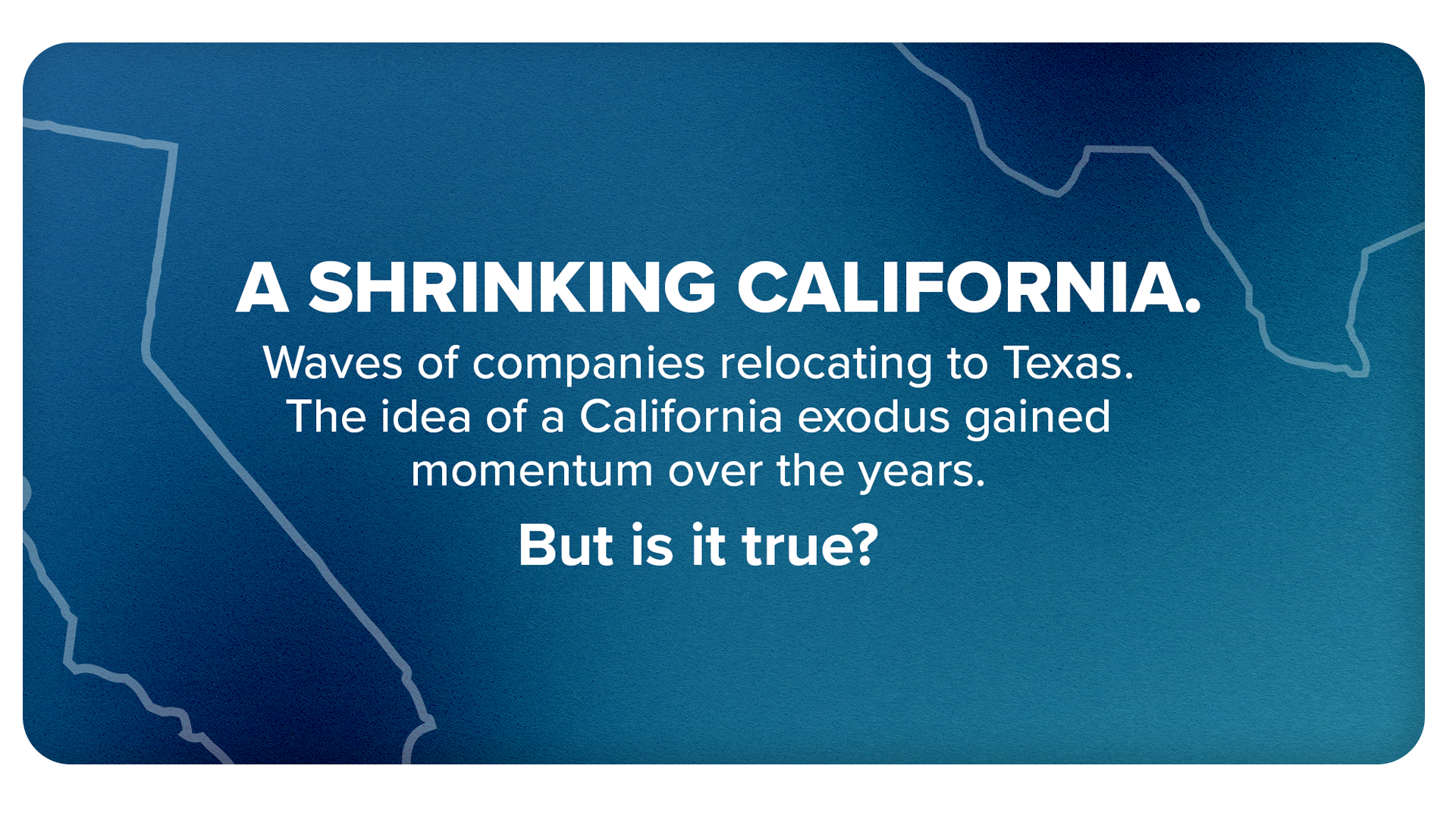This narrative of the grass being greener in Texas than California turbo charged over the pandemic.
In a special year-long project, we followed the paths of eight former Californians who uprooted and left for the Lone Star State. Through a combination of video logs and interviews, plus a deep dive trawling through publicly available data and several record requests, we’ve pieced together a picture of those who made the move.
Our dig into the data has separated fact from fiction.
Watch California Dreaming: Moving to Texas
> FACT:
California's population is shrinking
Between April 2020 and July 2022, California's population dropped by more than half a million people, according to the latest population estimates from the U.S. Census Bureau. This is the first instance of population loss for the Golden State in 170 years.
Newly released data from the California Department of Finance shows the state lost about 138,400 of the population in 2022, which is a 0.35% decline.
Of the state’s 58 counties, 46 decreased in population last year. This is a smaller percentage than the population drop in 2021, mainly due to the large increase in foreign immigration, which nearly tripled from 2021 to 2022.
FACT:
Texas is the top state Californians are moving to
Based on U.S. Census American Community Survey migration data from 2009 to 2019, Texas has been the #1 destination for departing Californians within the last decade. During that time period, an average of about 68,700 Californians moved to Texas each year.
A steady flow of Californians leaving for Texas outpaced the reverse flow of Texans moving to California by 2-to-1 during a notable spike in 2018 and 2019.
According to relocation website MoveBuddha, in the first six months of 2022, there were 4,500 searches for California to Texas and 1,345 searches for Texas to California. Texas was the top searched destination for Californians that use their services.
FACT:
During the pandemic, the migration accelerated
The number of California driver’s licenses surrendered in Texas jumped 46% from the three years before the pandemic to the three years during the pandemic, according to the Texas Department of Public Safety. According to the Texas Department of Motor Vehicles, new residents have to obtain a Texas driver’s license within 90 days of moving to the state, which requires giving up out-of-state licenses.
FACT:
There is not a mass exodus going on
If you add up all the people who moved to Texas within the United States and subtract those who moved away from 2009 to 2019, otherwise known as net domestic migration, 34 percent came from California.
However, it’s important to note that of the almost 40 million people living in California, the total number leaving the state per year make up less than 1% of the population.
So why are people moving to Texas?
We condensed months of conversations and hours of interviews with eight former Californians of varying backgrounds. Some say their decision was tied to politics. Others cited safety. But every one said the choice was fraught with emotion and based on a myriad of factors rather than just one.
Are California's perceived issues real?
The people we interviewed cited several reasons for moving, including safety and housing costs. Are these issues as real as they are perceived?
Let’s fact check those reasons for moving:
FACT:
During the last decade, property crime was almost always higher in Texas than California
According to FBI data, the 2020 rate of property crime per 100,000 people was about 2,139 in California and 2,245 in Texas. Over the last decade, Texas almost consistently had a higher rate of property crime than California.
FACT:
Violent crime fluctuates per year in Texas and California
In 2020, the rate of violent crime per 100,000 people was 442 in California and around 447 in Texas. However, violent crime rates tend to fluctuate yearly and for some years during the last decade, the two states overtook one another.
FACT:
California housing prices are dramatically higher compared to the rest of the US
Eight of the 10 cities with the highest housing costs in America are in California, according to 2018 data crunched by the Federal Reserve and Bureau of Economic Analysis with data adjusted for the higher salaries in California.
Housing costs in San Francisco are 190% higher than the norm nationwide. They’re 120% higher in San Jose.
Seventeen of the 26 California cities included in the data are above the United States norm.
The average home in California is valued at around $728,134 while the average home in Texas is valued at around $294,336, according to the March 2023 Zillow Home Value Index, which is a measure of the typical home value for all housing types.
FACT:
Cost of living is also higher in California compared to other states
The Bureau of Economic Analysis found when you combine housing, goods and services all together into real purchasing power for people, California is 15% more expensive to live in than the overall United States. The data shows that costs for goods (food, cars, gas, furniture) are 4% higher than the entire US on average and costs for services (auto repair, health care, etc). are 7% higher on average.
FACT:
California is worse off than Texas in terms of business taxes (but many are still opening new businesses in the Golden State)
While there's no way to compare overall business costs state-by-state, we looked at tax data to get a partial look at business expenses in California compared to Texas.
California is listed as the third lowest ranked state in The Tax Foundation’s 2023 State Business Tax Climate Index. According to the independent tax policy non-profit, this means California’s tax system is overall worse off than all but two other states. Texas is ranked 13th.
The only category where Texas didn't have a better or similar ranking to California was for property taxes -- Texas is ranked 38th and California is ranked 24th.
Taxes don’t seem to be dissuading people from creating businesses in California. In 2022, both states saw a similar number of submitted business applications, according to Census data. Taking population into account, Texas had about 1,557 applications per 100,000 people and California had around 1,253 per 100,000 people.
FACT:
Both states have conservative and liberal populations
There's no good, recent data for comparing personal and political values at a state-by-state level (believe us, we looked everywhere). But we're able to get a general sense based off a couple of data points.
We couldn’t look at voter party registration because recent data is not available for Texas. When a person registers there, they do not list a party affiliation.
So we looked at voting percentages by candidate for the 2020 presidential election to determine how both states lean politically.
In Texas, 46% voted for Biden and 52% voted for Trump. In California, 63% voted for Biden and 34% voted for Trump.
For personal values, the best and most recent data comes from a 2018 Gallup poll. The organization found 29% of Californians are conservative and 29% are liberal. In Texas, 38% are conservative and 20% are liberal. Moderates made up 36% of participants for both states.
Based on the above, Texas is more conservative and right-leaning than California, but both states encompass individuals across the entire political spectrum.
One year later
Is it everything they dreamt it would be?
Of the eight we spoke with over the course of a year, the majority were happy with their decision to move to Texas. However, many expressed nostalgia for the people, places and things they missed while living in California.
Half were open to returning to the Golden State.
“I might stay here, I might go back,” said Bill Fulton. “If you define the American dream as living in a big house on a big lot. Yes, it's easier to live in Texas. But California is still a great place for people to pursue their dreams depending on what they're looking for.”
While the other half said they were absolutely staying.
“(To move back) the whole state would have to clean up, get some of those rotten politicians, be tough on crime again,” said Simon Black. “People's attitudes will just have to change. But for the most part I really am happy here. I have very little desire to move back as a whole.”
Many who rented in California, due to the lack of housing affordability, were able to buy homes for the first time.
Bob Kim bought a house in Denton, Texas that reduced his commute to work to seven minutes and cites safety as a reason to stay,
“My wife feels completely safe here,” Kim said. “And that really was the major criteria for moving here.”
Kelly Brown bought a house with a pool in Katy, Texas. However, she did not sell her house in the Bay Area.
“I left that option open,” Brown said. “But I think that (it) will always feel like home to me. I've only been in Texas for 14 months. We'll see, I might go back. And I might stay.”
Watch, “California Dreaming: Moving to Texas,” now to see everyone’s opinion of Texas a year after the move.
Credits
EXECUTIVE PRODUCER: Brandon Behle. PRODUCER: Pamela Parker. PRESENTER: Karina Nova. DATA JOURNALIST: Lindsey Feingold. WEB DESIGN AND DEVELOPMENT: Lindsey Feingold. EXECUTIVE PRODUCER OF DIGITAL: Kimberlee Sakamoto. VISUAL CONTENT PRODUCER: Adriana Aguilar. GRAPHIC ARTISTS: Danny Tulledge, Jason Parker and Jeremy Stepp. SUPERVISING EDITOR: Jericho Saria. EDITOR: Pamela Parker. CAMERA: Pamela Parker and Juan Carlos Guerrero. SPECIAL THANKS: MoveBuddha, Grace Manthey, Texas Department of Public Safety, Kinder Institute For Urban Research, Texas A&M University, Move to Texas From California and Treehorn Books.
Ⓒ 2023 ABC Owned Television Stations









